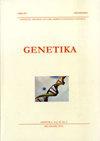Performance of basmati rice (Oryza sativa L.) genotypes under different crop establishment methods
4区 农林科学
Q3 Agricultural and Biological Sciences
引用次数: 0
Abstract
The study was conducted to evaluate the performance of thirty-six Basmati rice genotypes for yield and its related traits under direct-seeded rice (DSR), system of rice intensification (SRI), chemical-free cultivation (CFC), and conventional transplanted rice (TPR).The genotypes were evaluated for two years at two locations in randomized block design with three replications. Genotype Pusa Basmati 1121 scored highest ~22% yield increase in system of rice intensification method over transplanted rice followed by Pusa Basmati 1 (~20%) genotypes HKR 11-447 (~18 %). Genotype Pusa Basmati 1, Pusa Basmati 1637-2-8-20-5 and Pusa Basmati1734-8-3-85 produced 8-16 % higher yield in chemical-free cultivation in comparison to TPR. Genotypes HKR 98-476, CSR 30, PAU 6297-1 yielded equally in DSR as well as in TPR. All the genotypes under study showed earlier flowering and maturity in DSR followed by SRI and TPR=CFC. Pusa Basmati 1509recordedthe earliest flowering across the environments. Most of the genotypes showed an increase in panicle weight, number of tillers per plant, number of spikelets per panicle, percent filled spikelets, Biological yield, and grain yield under SRI over other methods of rice crop establishment. Among different methods, SRI was found best than TPR, CFC, and DSR (wet).印度香稻基因型在不同建种方法下的表现
研究了36个巴斯马蒂稻基因型在直接播种水稻(DSR)、水稻强化栽培系统(SRI)、无化学栽培(CFC)和常规移栽水稻(TPR)条件下产量及其相关性状的表现。采用随机区组设计,3次重复,在两个地点对基因型进行为期两年的评估。在水稻集约化系统中,基因型普萨巴斯马蒂1121比移栽水稻增产最高,约22%,其次是基因型普萨巴斯马蒂1(增产约20%)和基因型HKR 11-447(增产约18%)。与TPR相比,基因型Pusa Basmati1、Pusa Basmati 1637-2-8-20-5和Pusa Basmati1734-8-3-85在无化学栽培中产量提高了8- 16%。基因型HKR 98-476、CSR 30、PAU 6297-1在DSR和TPR上的产量相等。所有基因型均表现为DSR较早开花和成熟,其次是SRI和TPR=CFC。Pusa Basmati 1509记录了整个环境中最早的开花。大多数基因型在水稻单株分蘖数、单穗粒数、实粒率、生物产量和籽粒产量方面均高于其他水稻种植方法。在不同的方法中,SRI比TPR、CFC和DSR(湿法)效果更好。
本文章由计算机程序翻译,如有差异,请以英文原文为准。
求助全文
约1分钟内获得全文
求助全文
来源期刊

Genetika-Belgrade
AGRONOMY-GENETICS & HEREDITY
CiteScore
1.80
自引率
0.00%
发文量
1
审稿时长
6-12 weeks
期刊介绍:
The GENETIKA is dedicated to genetic studies of all organisms including genetics of microorganisms, plant genetics, animal genetics, human genetics, molecular genetics, genomics, functional genomics, plant and animal breeding, population and evolutionary genetics, mutagenesis and genotoxicology and biotechnology.
 求助内容:
求助内容: 应助结果提醒方式:
应助结果提醒方式:


